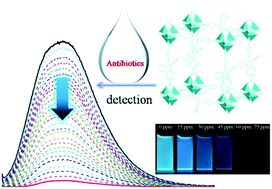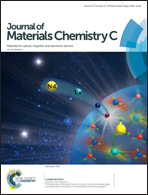A new luminescent metal–organic framework based on dicarboxyl-substituted tetraphenylethene for efficient detection of nitro-containing explosives and antibiotics in aqueous media†
Abstract
In this work, we synthesized a dicarboxyl-substituted tetraphenylethene (TPE) ligand, 4,4′-(1,2-diphenylethene-1,2-diyl)dibenzoic acid (H2BCTPE), with a prominent aggregation-induced emission (AIE) feature. A two-fold interpenetrated luminescent metal–organic framework (LMOF) [Zn4O(BCTPE)3] (1) with Zn4O(CO2)6 nodes is prepared using the trans-isomer of H2BCTPE as a ligand, which shows a typical behavior of microporous materials and a high fluorescence quantum yield of 64.5%. The solvent free 1 is thermally stable, water stable and highly emissive. The suspension of solvent-free 1 in water exhibits high quenching efficiencies and low detection limits towards nitro-containing explosives (e.g. nitrobenzene, 4-nitrophenol, 2,4,6-trinitrophenol), and nitro-containing antibiotics (e.g. metronidazole and nitrofurazone). The solvent-free 1 can be a promising alternative to efficiently detect nitro-containing explosives and antibiotics under aqueous conditions.



 Please wait while we load your content...
Please wait while we load your content...